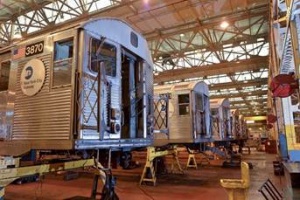Oldest MTA New York City transit subway cars getting final makeover

Maintenance on R32s will keep them on the rails until the new R179 cars are delivered. With their once-gleaming stainless-steel bodies dulled by age and their windows scarred by the negative attention of vandals, MTA New York City Transit’s R32 subway cars are living out their final years of service until the arrival of their replacements. In order to make those last trips go more smoothly, however, the cars are “having a little work done.”
The “Brightliners,” as the Budd-built cars were dubbed upon their introduction into service back in 1964, were the first large fleet of stainless steel cars purchased by New York City Transit and the first corrosion resistant cars placed in service since the ten experimental cars purchased in 1949 by the New York City Board of Transportation.
Thanks to the combination of stainless steel construction, efficient design and the efforts of New York City Transit’s subway car maintenance forces, the cars have held up admirably for nearly half a century, serving riders on nearly every lettered line route. Currently operating on the A and C lines, the cars have a distinctive ribbed sided appearance, rather than the smooth sides of more modern subway cars.
Today, the remaining 222 cars out of the original 600-car fleet are rotating through the Coney Island Overhaul Facility at a pace of four cars per week undergoing a limited-scope maintenance makeover intended to improve their performance and reliability until they are replaced by the fleet of 300 new R179 cars, due to begin arriving in 2014.
“The work currently being performed on these cars will help increase customer comfort and insure service reliability until their replacements arrive,” said Carmen Bianco, Senior Vice President of the Department of Subways.
ADVERTISEMENT
With a projected cost of nearly $25 million, the scope of work includes upgrades to several major car components and systems including; air brakes, auxiliary electric, car body, couplers, car body hoses, door systems, propulsion systems, some HVAC work and trucks. Work will also include structural enhancements and the replacement of vandalized windows.
Work is scheduled for substantial completion by the end of this year with air conditioning and structural improvements wrapped up by the beginning of next year’s hot weather season.

